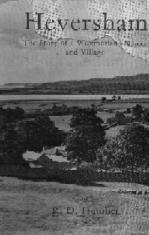

Extract from - Humber R.D. (1968) Heversham: The Story
of a Westmorland School and Village. Kendal; Titus Wilson
This
book describes the history of the village, the area and Heversham School as it
then was. Brigadier C.F. Wilson of Dallam Tower wrote the foreword –
‘A
true story, either told or written, is, I believe, more satisfying and
worthwhile than fiction, especially when it is about real people, their life in
a village or school, with the ups and downs of life in a community. Robert
Humber has put together anecdotes and facts of a Westmorland village, over a
period starting some 350 years ago, when my ancestor, Edward Wilson of Nether
Levens Hall, founded in 1613 a Grammar School on Heversham Head. The book is the
more interesting to me, because it brings back happy memories of my childhood
days at Dallam Tower, when Tom Stainton taught me to fish, John Tarves used to
look after us at the various parties we used to go to, and old John Handley was
so kind and helpful to Heversham and to its School. During this period my uncle,
Sir Maurice Bromley-Wilson, was forever impressing on me the important part
which Heversham Grammar School had played in my heritage. All through this book
runs a tradition of local loyalty to the School, and this strong support was
shown again in 1966, when an Appeal to finance future building raised some £72,000
in a few months, making possible many major improvements which are now in hand.
Robert Humber, an Old Boy of Heversham Grammar School, is giving the proceeds
from the sale of this book to the Appeal Fund. The School still flourishes, now
with 270 boys, and with a fine record of educational achievement. Long may the
School carry out its Founder's hopes and wishes.’
Chapter
1 of the book begins as follows –
‘Edward
Wilson of Nether Levens founded Heversham Grammar School on the brow of the wood
capped hill known as the Head. He built a stout limestone house surmounted by
the rounded traditional Westmorland chimney stacks, standing above the ancient
church and village of Heversham, mentioned as Evreshaim in Domesday.
After
centuries of strife and bloodshed between Scot and English in the northern
counties, the accession of James I in 1603 as King of England and Scotland,
persuaded the lawless moss-troopers to abandon the sword for the shepherd's
crook.
The
fortress pele-towers by dale and estuary, probably built as much for protection
from a rapacious neighbour, as shelter from the raiding Scot, gradually became
merged into peaceful farmhouse, or stately mansion. Likewise the defeat of the
Armada in 1588 had left sea power in Britain's mastery. The dawn of peace in the
English valleys and hills led to the first erection of stone built cottages and
hamlets in the north country. Formerly stone had been employed mainly for
fortified castle and pele-tower, for owing to periodic warfare, and constant
skirmishing raids, no man dare put his faith and energy into the labour of
building a permanent dwelling.
Men
of learning and vision found opportunity to build good works that lived after
them. It is greatly to the credit of Edward Wilson that at this time, when he
was busy founding a fair estate for his own family in South Westmorland, he
should be moved to benefit the parishioners of Heversham, by founding the
school, and providing a charity for the poor and needy villagers. He chose a
lovely situation for his school and adjacent cockpit. The furzy hill dips to the
church and the straggle of limestone cottages and farmhouses nestling at the
foot of the hill. Beyond, the land levels out in the mosses reaching to the sea
wall and the glittering wind of the River Kent, snaking through the moss-green
plain to the sea. Faraway westward beyond the dark peat hags of Foulshaw Moss
and the white cliffs of Whitbarrow Scar, the gap-toothed tusks of Langdale gape
on the horizon. A fair land of shining waters and tawny sands, where the fell
becks merge with the sea, green hills and glinting white limestone scars lay
comely all around, and behold in the north the eagle wings of the Lakeland
fells. The sea breeze carries on it the restless murmur of wildfowl in the
estuary.’
A
district of unchanging names, faithful to the manor and the land, of strange
legends and customs slowly crumbling away like the fortress pele towers guarding
the estuary.
©
Robert D. Humber/Titus Wilson & Son of Kendal